Affiliate Onboarding Guide: 11 Steps to Build Strong Partnerships

In this article
Why Affiliate Onboarding Matters
Step #1. Pre-Onboarding: Setting the Stage Before They Join
Step #2. Create a High-Converting Affiliate Registration Process
Step #3. Send a Warm, Personalized Welcome Email
Step #4. Provide an Orientation Session or Webinar
Step #5. Automate the Affiliate Onboarding Workflow
Step #6. Give Access to an Affiliate Resource Hub
Post-Onboarding Management
Step #7. Integrate Tracking and Reporting Tools
Step #8. Establish a Regular Communication Plan
Step #9. Monitor Early Engagement and Offer Support
Step #10. Gather Feedback with Surveys
Step #11. Continuously Refine Your Onboarding Process
Wrapping up: Turning Onboarding into a Long-Term Growth Driver
The way you welcome your potential promoters can shape the entire partnership. A smooth affiliate onboarding experience gives them the tools and confidence to start promoting right away, along with the motivation to keep going. Done well, it turns sign-ups into committed partners who deliver consistent results.
In this guide, you’ll find a step-by-step process for building an onboarding journey that attracts the right affiliates, sets them up for success, and keeps them engaged for the long term.
Let’s delve into the details.
Why Affiliate Onboarding Matters
Onboarding should become the affiliates’ “aha” moment when their interest turns into action. A well-structured onboarding gives your partners the clarity, resources, and confidence to start promoting right away and to keep going. That’s why, just as a theatre experience begins in the cloakroom, your affiliate program should start long before a potential partner completes their registration.
According to recent affiliate marketing benchmarks, the average activation rate (new affiliates who launch campaigns) sits around 10%, while top-performing programs hit 50% or more. Just feel the difference.
Key points to remember:
- The link between onboarding and performance: The first 30–60 days after signup are critical. Affiliates who get their first clicks or sales quickly are far more likely to stay engaged. Early wins create momentum and lead to higher long-term earnings.
- Common onboarding mistakes to avoid: Slow approvals, incomplete training, hard-to-find promotional materials, and poor communication can stall affiliates before they start. Clear processes and quick support dramatically improve activation rates.
To make a long story short, let’s proceed with the crucial onboarding steps.
Step #1. Pre-Onboarding: Setting the Stage Before They Join
Onboarding starts long before an affiliate logs into your portal. It begins the moment they discover your program through your affiliate landing page, a listing in a marketplace, or a recommendation from another partner. That first impression shapes their perception and their decision to apply.
A high-converting landing page or listing should highlight:
- Clear commission rates and payout schedule
- Promotional guidelines
- Key benefits of partnering with your brand
Engaging Affiliate Landing Page Examples
- BÏRCH’s affiliate program page stands out for its clear presentation and detailed breakdown of how the program works. It gives potential partners a solid understanding of the benefits and requirements before applying. One standout feature is the offer of a dedicated partnership manager after onboarding, which signals strong long-term support. The page’s clean, well-structured layout makes all this information easy to digest at a glance.
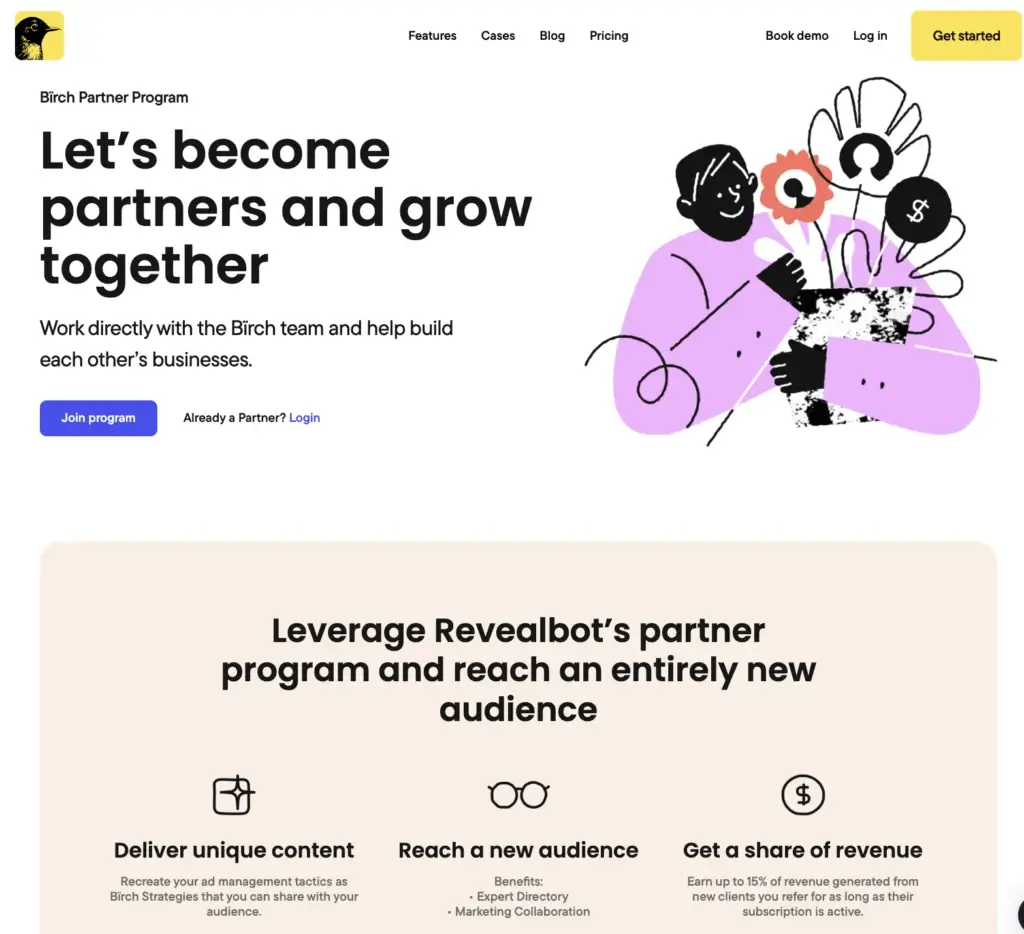
- Going has become a top choice for millions of deal-seekers looking for exclusive travel offers, as well as for thousands of affiliates who use the program to earn extra income while accessing unbeatable prices. The page itself strikes a nice balance between a polished and approachable design, making it easy to find all the key details in just a few clicks.
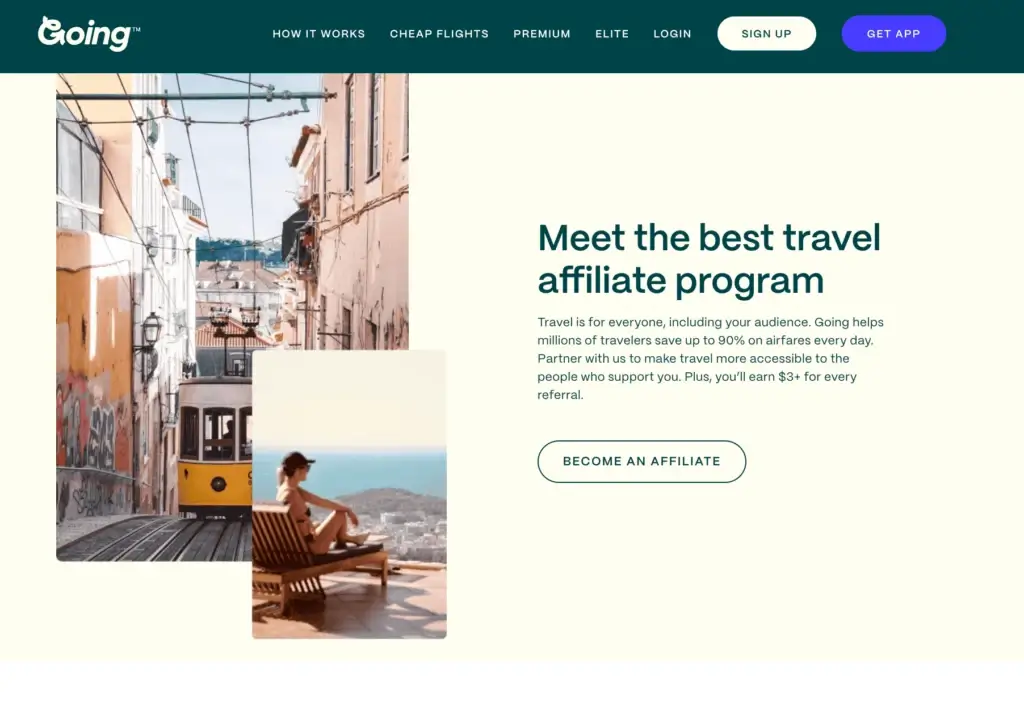
- Designmodo’s affiliate page wastes no time in highlighting the most important detail, such as the commission rate, right at the top of the page. It also features a handy earnings calculator that lets potential partners estimate their income, plus testimonials from existing affiliates toward the bottom, adding credibility and social proof.
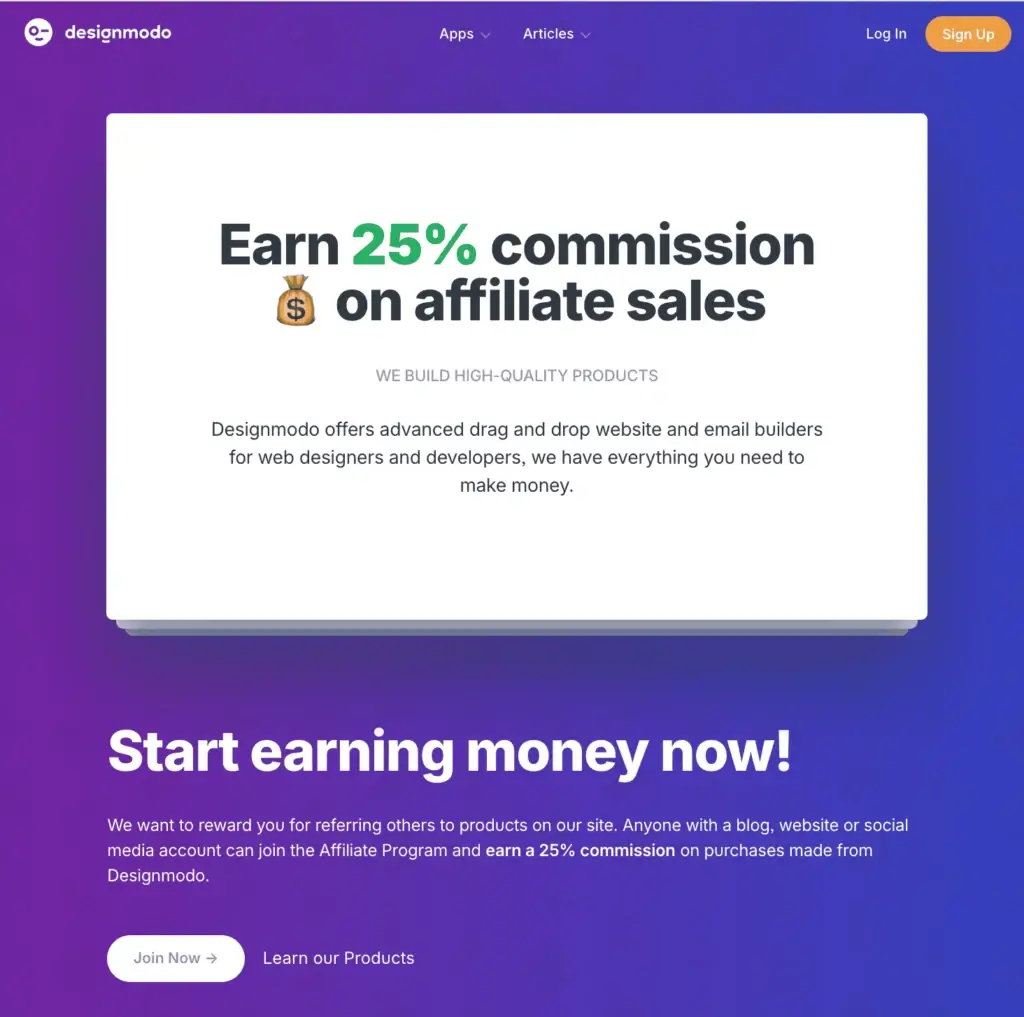
TIP: Set expectations from day one. Outline your commission structure, payment schedule, promotional rules, and important campaign dates. Affiliates who have this clarity early are less likely to make mistakes that slow them down.
Step #2. Create a High-Converting Affiliate Registration Process
The registration form is your first real point of contact with a potential affiliate. If it’s long or complicated, many will abandon it before finishing. The goal is to keep it short, easy, and clear. So, make sure you don’t overload your signup form with too many fields and collect only what really matters.
With Tapfiliate, you can design a fully white-labeled signup page with your own logo and domain for a seamless brand experience. You can also customize the form so it captures just the key details you need, without adding unnecessary friction.
Essential affiliate registration fields to include
- Full name: For communication and account identification.
- Email address: Your primary channel for sending the welcome email, affiliate link, and onboarding instructions.
- Password: So they can log into their portal right away.
That’s all you need at the first step. Keep it quick.

Step #3. Send a Warm, Personalized Welcome Email
A welcome email bridges the gap between approval and active participation. It should be friendly, clear, and lead the affiliate directly to their first actions.
What to include in the welcome email
- Personalized greeting and confirmation of acceptance
- Their unique affiliate link so they can start promoting immediately
- Login link to their affiliate portal
- A short checklist for first steps (update profile, select creatives)
- Contact details for support
With Tapfiliate’s Triggers feature, you can automate this message so it arrives instantly after approval. New affiliates can log in, explore their dashboard, and message you through the built-in messenger.
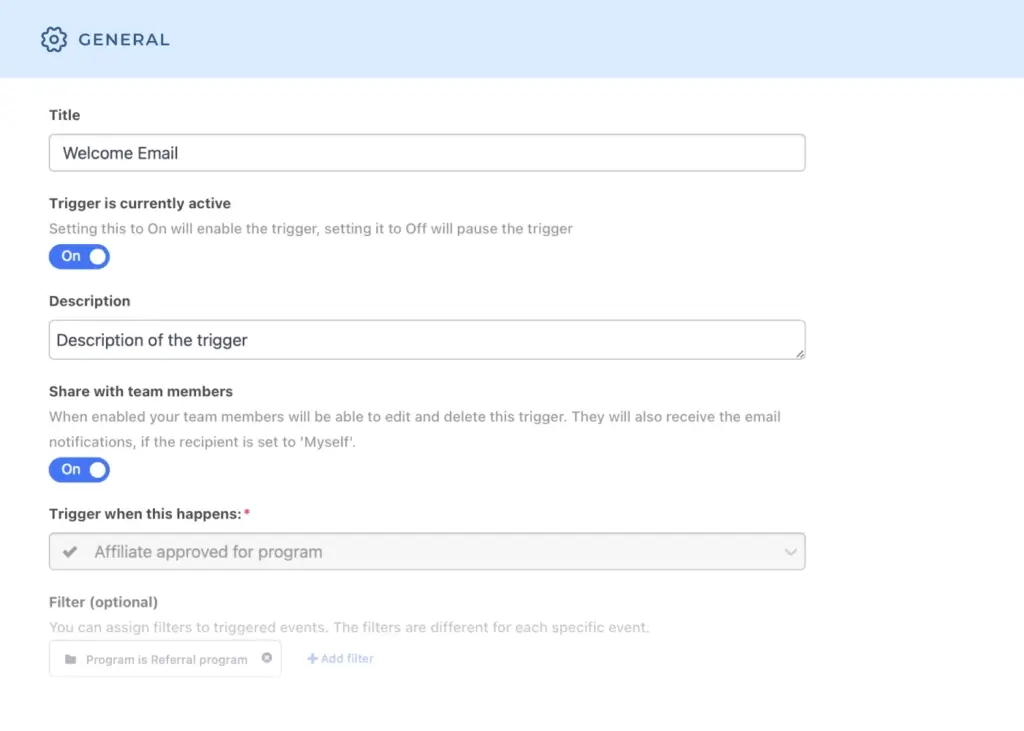
Email marketing benchmarks show that welcome emails see open rates four to five times higher than standard newsletters, making this a high-impact step.
Need the welcome email template to greet your affiliate prospects? Here you are:
Subject: Welcome to the [Your Program Name] Affiliate Program
Hi [First Name],
We’re excited to have you on board! Your affiliate account is now active, and you can start earning commissions immediately.
Here’s your unique referral link: [Affiliate Link Placeholder]
Share this link on your website, social media, email list, or anywhere you promote. Every time someone clicks it and makes a purchase, you’ll earn commission.
Your first steps
- Log in to your affiliate portal: [Portal Login Link]
- Update your profile details
- Download creatives from the resource hub
- Join our private affiliate group (optional): [Group Link]
If you have any questions or need support, contact us at [Support Email].
Welcome to the team, and let’s make this a success!
[Your Name]
Affiliate Manager, [Your Company]
Step #4. Provide an Orientation Session or Webinar
An orientation session helps affiliates understand your program, tools, and the most effective ways to promote.
Live vs. recorded onboarding sessions
Live sessions allow real-time Q&A, while recorded versions provide flexibility. Offering both maximizes accessibility.
Webinar engagement statistics reveal that nearly half of attendees prefer watching a replay, making recorded sessions a valuable resource.
TIP: Use Tapfiliate’s in-platform messenger and notifications to promote these sessions and store replays in your resource hub.
Covering policies, goals, and incentives
Use your orientation session to make sure affiliates understand:
- Commission structure: Explain rates, tiers, and how payouts work.
- Promotional restrictions: Clarify what’s allowed and what isn’t (e.g., use of brand keywords, restricted channels).
- Marketing goals: Outline the key objectives for your program, such as targeting certain products, markets, or seasonal campaigns.
- Examples of high-converting campaigns: Show real examples to inspire affiliates and give them a proven starting point.
- Incentive programs: Introduce any extra rewards like tiered payouts, seasonal bonuses, or contests.
This ensures new affiliates leave the session with both the rules and the motivation to start promoting effectively.
Step #5. Automate the Affiliate Onboarding Workflow
Manual onboarding can work when you have just a handful of affiliates, but as your program grows, it quickly becomes time-consuming and prone to inconsistencies.
Automations ensure that every affiliate gets the same smooth experience without your team repeating the same tasks over and over. They also reduce the risk of missing important steps, such as sending the welcome email or granting access to creatives.
Depending on the size of your program, automating onboarding can save several hours each week, the time you can spend on recruiting, optimizing campaigns, or providing personal support to high-value affiliates.
Using affiliate software and integrations
A dedicated affiliate platform like Tapfiliate can automate invites, approvals, and email sequences. Integrations with your CRM and e-commerce tools can also speed up tracking setup and asset delivery.
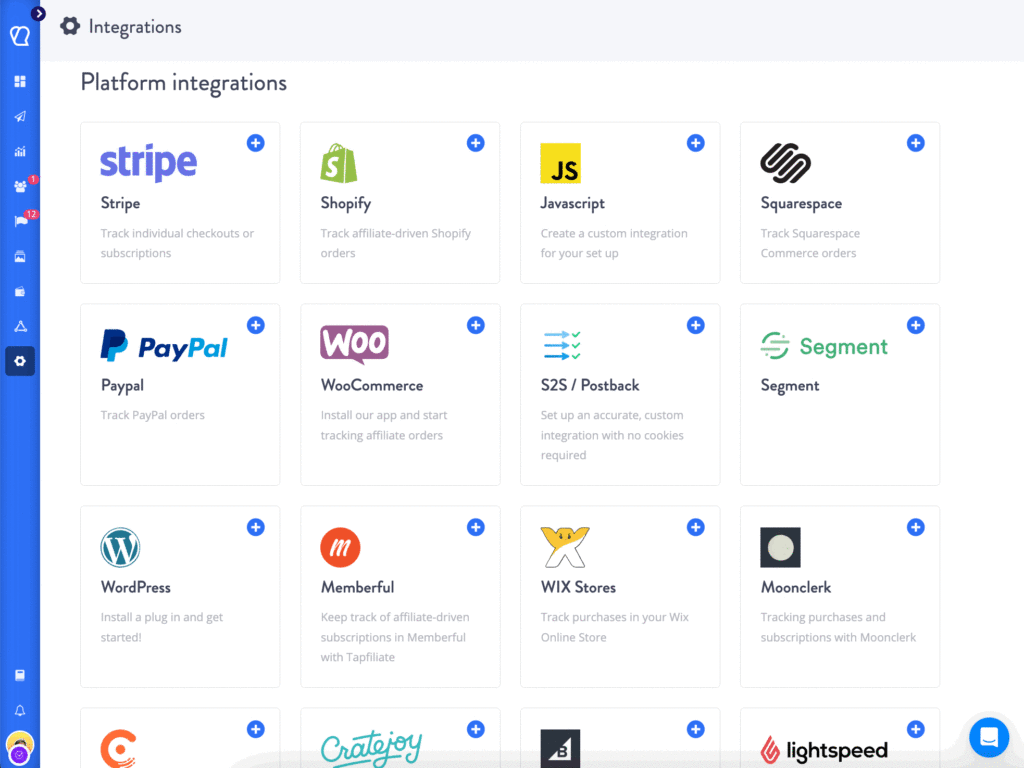
Creating a standardized checklist
Document the actions in your automation workflow so they run consistently for each new affiliate. This is the list of repeatable steps you want to automate or template at this stage to save time and avoid human errors.
Example items for your automation checklist:
- Auto-approve affiliates who meet set criteria
- Trigger a welcome email with a unique referral link
- Grant instant access to the affiliate portal and resource hub
- Send an automated invite to the next live or recorded orientation
- Trigger follow-up email after 7-14 days if no activity
- Notify your team via CRM or Slack when a new affiliate joins
This focused list helps ensure your automations are complete, consistent, and working in the background while you move on to the next onboarding stages.
Step #6. Give Access to an Affiliate Resource Hub
Help your affiliates promote you by equipping them with all the necessary branded materials. A well-organized resource hub reduces friction, ensures brand consistency, and supports better performance across different affiliate types.
Marketing assets, branding kits, and FAQs
Ready-to-use materials such as banners, product images, email templates, and a style guide allow affiliates to launch campaigns quickly, keeping your messaging on point.
Yes, we know that many influencers and content creators may prefer to make their own visuals. On the other hand, many affiliates, like coupon sites, review publishers, and paid media buyers, rely on having pre-built creatives they can plug into their platforms immediately.
Additionally, a strong branded kit also ensures affiliates aren’t using outdated or off-brand visuals, protecting your brand identity. With Tapfiliate, you can upload, organize, and update assets into clear categories so affiliates can download them anytime without waiting for approval.

Training modules and best practice guides
Pair your creative assets with guides and training. Short videos or PDF tutorials on topics like link tracking, choosing the right creatives, or optimizing campaigns help affiliates make the most of the materials provided.
Real-world examples of great affiliate resource hubs
- Shopify Affiliate Program offers a clean dashboard with categorized resources, from brand guidelines to copy templates, making it easy for affiliates to grab exactly what they need. (Shopify Affiliate Program)
- ConvertKit Affiliate Program includes a library of banners, email swipe copy, and tutorial videos, plus a seasonal promotion calendar so affiliates can align campaigns with product launches. (Kit Affiliate Program)
Example Resource Hub Structure
- Getting Started: Quick-start guide, program rules, welcome video
- Creatives: Banners (various sizes), logos, product images
- Copy Templates: Email swipes, social media post templates
- FAQ: Common questions and answers about commissions, payouts, and tracking
We understand that Rome wasn’t built in a day. So, unless you are operating at the scale of companies like Shopify or Kit and have the resources to build an extensive hub from day one, you can start small. Focus on the most essential materials your affiliates need right now, and then expand your library as your program, business, and team grow.
Testing how your tracking works before you launch the program ensures affiliates can start with confidence. By this point, they have the tools, assets, and information needed to promote effectively. But your job as a program manager doesn’t stop here.
So, keep calm and carry on.
Post-Onboarding Management
The first six steps we’ve already listed focus on what happens from the moment an affiliate applies through their initial setup and activation. But onboarding doesn’t exist in a vacuum. How you manage affiliates in the weeks and months after they start also influences their perception of your program, their trust in your brand, and their long-term performance.
That’s why we included five more steps, which cover post-onboarding management activities.
While these actions are part of ongoing affiliate program management, they help ensure that the time and resources you invested in onboarding lead to higher activation rates, stronger retention, and better results over the long term.
Step #7. Integrate Tracking and Reporting Tools
Transparent tracking builds trust and gives affiliates the information they need to improve their campaigns. This way, by putting reliable tracking in place right after onboarding, you create a foundation for long-term collaboration.
Setting up tracking links and dashboards
Assign unique tracking links to each affiliate and show them how to view their performance data in their accounts (in case you opt for using affiliate tracking software).
Affiliate tracking best practices stress the importance of real-time data for optimizing campaigns and maximizing ROI.
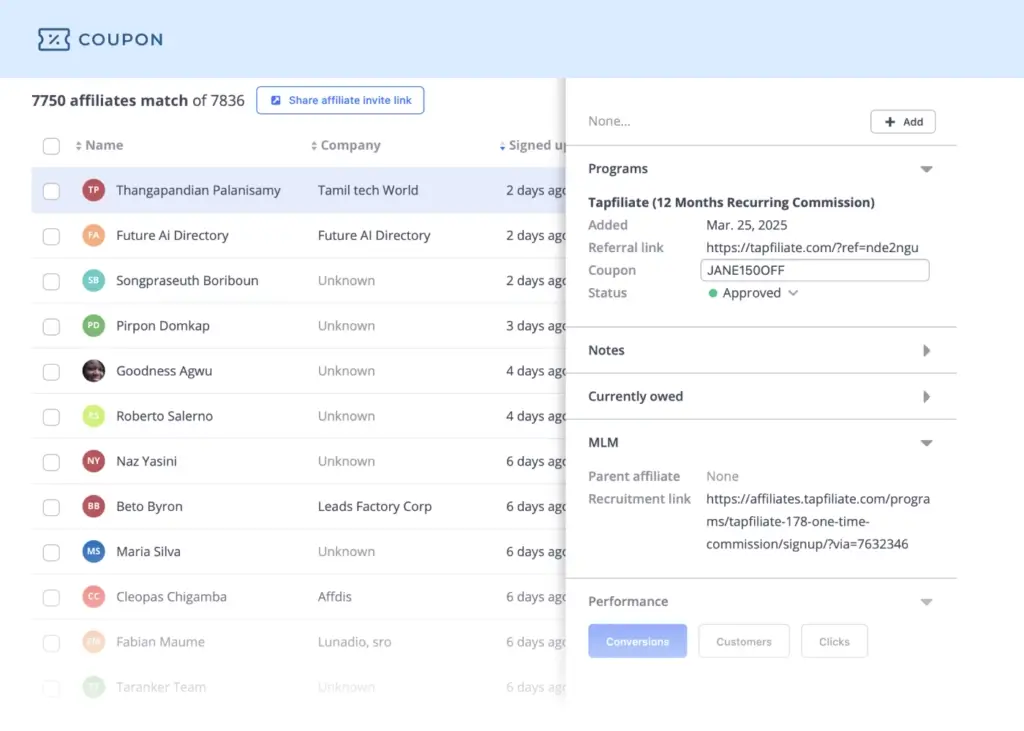
Testing for accuracy before launch
Before affiliates go live with their promotions, test all tracking links and verify that clicks and conversions are recorded correctly. This step prevents disputes and strengthens confidence in your program’s reliability.
Step #8. Establish a Regular Communication Plan
Start treating affiliates as your team members who help your business grow. Since affiliate marketing is not just a “set-it-and-forget-it” story, consistent communication keeps affiliates engaged, informed, and motivated. Also, it builds a relationship where your promoters feel supported and aligned with your program’s goals.
So, the most important rule here is to keep them regularly updated.
The updates can include:
- Product education: Teach affiliates about your products or services so they can promote them accurately and confidently.
- Product updates and new releases: Let them know when you add new features, product lines, or services so they can update their promotions.
- Sales and special offers: Announce seasonal promotions, flash sales, or bundle deals so affiliates can act quickly.
- Price changes: Inform affiliates in advance so they can adjust their marketing and avoid outdated information in their content.
- Performance tips: Share strategies, campaign ideas, or examples from top performers to inspire others.
When affiliates have the knowledge, updates, and support they need, they can focus on creating content, driving traffic, and generating conversions.
Step #9. Monitor Early Engagement and Offer Support
In the first 30-60 days, track essential engagement signals such as logins to the affiliate portal, clicks on tracking links, and conversions. These metrics reveal how quickly affiliates are acting on the information and resources provided during onboarding.
Suppose an affiliate hasn’t logged in or generated clicks during this period. In that case, it may indicate they are unclear on how to start, overwhelmed by the process, or simply distracted by other priorities. Early detection gives you the chance to re-engage them while the initial interest in your program is still fresh.
Intervention strategies for inactive affiliates
When you identify affiliates with low or no activity, reach out directly with a personalized message and practical resources they can implement immediately. Examples include:
- A ready-to-use campaign pack with pre-written copy and matching creatives
- Seasonal or time-sensitive promotions they can plug into their channels
- Tips from top-performing affiliates to inspire and guide their approach
By removing barriers and offering easy wins, you give inactive affiliates a reason to re-engage.
Step #10. Gather Feedback with Surveys
Ready to keep fingers on the pulse of your affiliates’ performance? Actually, you have no other options if you want to succeed. So, let’s proceed with the feedback collection.
Ongoing feedback is essential for refining both your onboarding process and your long-term affiliate support. Surveys give you direct insights into what’s working well and where partners are running into challenges.
How to organize affiliate surveys
- Choose the right timing: Send your first survey shortly after onboarding, ideally within 30–45 days, while the experience is still fresh. A follow-up survey after 3–6 months can help you assess how ongoing support is perceived.
- Keep them short and focused: Limit surveys to 5–10 questions so affiliates are more likely to complete them.
- Offer an incentive: A small bonus, gift card, or entry into a prize draw can improve response rates.
- Mix question types: Use a combination of multiple-choice for measurable data and open-ended questions for richer insights.
Best questions to ask
- Was the signup process clear?
- Were the onboarding materials easy to find and useful?
- What would have helped you start faster?
- Are there specific resources you wish you had access to?
- How satisfied are you with communication so far?
Tools to use for surveys
If you don’t want to build a survey from scratch, several tools make it simple to create, distribute, and analyze affiliate feedback:
- Tally: Easy to use, with a generous free plan and a clean, modern interface
- Typeform: Known for its interactive, conversational survey format
- Google Forms: Free, quick to set up, and easy to integrate with spreadsheets for analysis
- Jotform: Offers advanced form logic and a wide range of templates
By collecting feedback at strategic points, you’ll have concrete data to improve your onboarding process, adjust resources, and make decisions that support your affiliates’ success.
Step #11. Continuously Refine Your Onboarding Process
We have some good (or sad) news for you! Onboarding is never “finished.” Yes, the most effective processes can only evolve when they are based on fresh data, affiliate feedback, and market changes.
It means that you won’t have time to rest on the laurels of previous achievements. Let’s see what to do next.
Reviewing performance metrics
Monitor key indicators such as:
- Time to first sale: Shorter times usually signal that your onboarding process is clear and effective.
- Activation rate: The percentage of new affiliates who launch campaigns within a set time frame.
- Retention rate: How many affiliates remain active after 3, 6, or 12 months.
- Average earnings per affiliate: A valuable measure of how productive your partners are after onboarding.
Iterating based on affiliate success stories
Look closely at your top-performing affiliates. Identify what helped them succeed early on, whether it was the clarity of your materials, quick access to resources, or personal support. Use these insights to shape the experience for future recruits.
Learning from other programs
If time allows, consider registering for other well-known affiliate programs in your niche or related industries. This lets you experience their onboarding firsthand and gather ideas for improving your own process. Take note of:
- How they present their program and benefits before signing up
- The flow and content of their welcome emails
- The quality and organization of their resource hubs
- The frequency and value of their early communication
By blending internal data with external inspiration, you can continually refine your onboarding to be more engaging, efficient, and aligned with affiliate needs.
Wrapping up: Turning Onboarding into a Long-Term Growth Driver
Affiliate onboarding goes far beyond sending a welcome email. It’s the starting point for building strong, long-term partnerships. The process you put in place before registration, the way you guide affiliates through setup, and the support you give after they start all play a huge role in whether they stay active and perform well.
No matter if you’re running a big, established program or just getting things off the ground, aim for an onboarding journey that’s clear, consistent, and easy to follow. Give affiliates the tools they need to promote confidently, keep the lines of communication open, and keep making small improvements based on results and feedback.
When your affiliates succeed, your program succeeds — and great onboarding is the fastest way to get there.
Plan to start your own affiliate marketing program?













